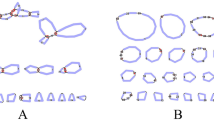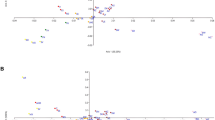Abstract
To define the matrilineal relationships between Bulgarians and other European populations, we have evaluated the mitochondrial DNA (mtDNA) variation in a sample of 855 Bulgarian subjects from the mtDNA perspective. The molecular survey was performed by sequencing ∼750 bp of the control region, which resulted in 557 different haplotypes, and by a subsequent restriction fragment length polymorphism analysis to confirm haplogroup/subhaplogroup affiliation. The classification was carried out according to the most updated criteria as reported by van Oven and Kayser (Hum Mutat 30:386–394, 2009), allowing the identification of 45 mitochondrial clades. The observed pattern of mtDNA variation indicates that the Bulgarian mitochondrial pool is geographically homogeneous across the country, and that is characterized by an overall extremely high frequency of western Eurasian lineages. In the principal component analysis, Bulgarians locate in an intermediate position between Eastern European and Mediterranean populations, which is in agreement with historical events. Thus, while the Mediterranean legacy could be attributed to the Thracians, indigenous people that firstly inhabited the Balkans, the Eastern contribution is likely due to the Proto-Bulgarians originating from the Middle East and to the Slavs migrating from northeast Europe.

Similar content being viewed by others
References
van Oven M, Kayser M (2009) Updated comprehensive phylogenetic tree of global human mitochondrial DNA variation. Hum Mutat 30:386–394. www.phylotree.org/tree/main.htm
Dobrev PD (1994) The world of the Proto-Bulgarians: truths, delusions. IKK “Slavika–RM”, Sofia
Dobrev PD (2005) The golden core of the Bulgarian antiquity. Tangra TanNakRa IK, Sofia
Haefs H (2009) Das goldene Reich der Pamir-Bulgaren an Donau und Wardar. Books on Demand, Nordtsedt
Torroni A, Achilli A, Macaulay V, Richards M, Bandelt H-J (2006) Harvesting the fruit of the human mtDNA tree. Trends Genet 22:339–345
Calafell F, Underhill P, Tolun A, Angelicheva D, Kalaydjieva L (1996) From Asia to Europe: mitochondrial DNA sequence variability in Bulgarians and Turks. Ann Hum Genet 60:35–49
Richards M, Macaulay V, Hickey E, Vega E, Sykes B et al (2000) Tracing European founder lineages in the Near Eastern mtDNA pool. Am J Hum Genet 67:1251–1276
Andrews RM, Kubacka I, Chinnery PF, Lightowlers R, Turnbull D et al (1999) Reanalysis, revision of the Cambridge reference sequence for human mitochondrial DNA. Nat Genet 23:147
Scozzari R, Torroni A, Semino O, Sirugo G, Brega A et al (1988) Genetic studies on the Senegal population. I. Mitochondrial DNA polymorphisms. Am J Hum Genet 43:534–544
Librado P, Rozas J (2009) DnaSP v5: a software for comprehensive analysis of DNA polymorphism data. Bioinformatics 25:1451–1452
Excoffier L, Laval G, Schneider S (2005) Arlequin ver. 3.0: an integrated software package for population genetics data analysis. Evol Bioinf Online 1:47–50
Soares P, Ermini L, Thomson N, Mormina M, Rito T et al (2009) Correcting for purifying selection: an improved human mitochondrial molecular clock. Am J Hum Genet 84:740–759
Kong QP, Bandelt H-J, Sun C, Yao YG, Salas A et al (2006) Updating the East Asian mtDNA phylogeny: a prerequisite for the identification of pathogenic mutations. Hum Mol Genet 15:2076–2086
Kivisild T, Shen P, Wall DP, Do B, Sung R et al (2006) The role of selection in the evolution of human mitochondrial genomes. Genetics 172:373–387
Olivieri A, Achilli A, Pala M, Battaglia V, Fornarino S et al (2006) The mtDNA legacy of the Levantine early Upper Palaeolithic in Africa. Science 314:1767–1770
Richards M, Macaulay V, Torroni A, Bandelt H-J (2002) In search of geographical patterns in European mitochondrial DNA. Am J Hum Genet 71:1168–1117
Roostalu U, Kutuev I, Loogväli E-L, Metspalu E, Tambets K et al (2007) Origin and expansion of haplogroup H, the dominant human mitochondrial DNA lineage in West Eurasia: the Near Eastern and Caucasian perspective. Mol Biol Evol 24:436–448
Loogvali EL, Roostalu U, Malyarchuk BA, Derenko MV, Kivisild T et al (2004) Disuniting uniformity: a pied cladistic canvas of mtDNA haplogroup H in Eurasia. Mol Biol Evol 21:2012–2021
Behar DM, Metspalu E, Kivisild T, Rosset S, Tzur S et al (2008) Counting the founders: the matrilineal genetic ancestry of the Jewish Diaspora. PLoS One 3:e2062
Torroni A, Bandelt H-J, Macaulay V, Richards M, Cruciani F et al (2001) A signal, from human mtDNA, of postglacial recolonization in Europe. Am J Hum Genet 69:844–852
Macaulay V, Richards M, Hickey E, Vega E, Cruciani F et al (1999) The emerging tree of West Eurasian mtDNAs: a synthesis of control-region sequences and RFLPs. Am J Hum Genet 64:232–249
Brandstätter A, Zimmermann B, Wagner J, Gobel T, Rock AW et al (2008) Timing and deciphering mitochondrial DNA macro-haplogroup R0 variability in Central Europe and Middle East. BMC Evol Biol 8:191
Soares P, Achilli A, Semino O, Davies W, Macaulay V et al (2010) The archaeogenetics of Europe. Curr Biol 20:174–183
Pala M, Achilli A, Olivieri A, Kashani BH, Perego UA et al (2009) Mitochondrial haplogroup U5b3: a distant echo of the Epipaleolithic in Italy and the legacy of the early Sardinians. Am J Hum Genet 84:814–821
Gonzalez AM, Garcia O, Larruga JM, Cabrera VM (2006) The mitochondrial lineage U8a reveals a Paleolithic settlement in the Basque country. BMC Genomics 7:124
Achilli A, Olivieri A, Pala M, Metspalu E, Fornarino S et al (2007) Mitochondrial DNA variation of modern Tuscans supports the Near Eastern origin of Etruscans. Am J Hum Genet 80:759–768
Coudray C, Olivieri A, Achilli A, Pala M, Melhaoui M et al (2009) The complex, diversified mitochondrial gene pool of Berber populations. Ann Hum Genet 73:196–214
Haak W, Forster P, Bramanti B, Matsumura S, Brandt G et al (2005) Ancient DNA from the first European farmers in 7500-year-old Neolithic sites. Science 310:1016–1018
Palanichamy MG, Zhang CL, Mitra B, Malyarchuk B, Derenko M et al (2010) Mitochondrial haplogroup N1a phylogeography, with implication to the origin of European farmers. BMC Evol Biol 10:304
Derenko M, Malyarchuk B, Grzybowski T, Denisova G, Dambueva I et al (2007) Phylogeographic analysis of mitochondrial DNA in northern Asian populations. Am J Hum Genet 81:1025–1041
Gresham D, Morar B, Underhill PA, Passarino G, Lin AA et al (2001) Origins and divergence of the Roma (gypsies). Am J Hum Genet 69:1314–1331
Acknowledgements
We are grateful to all the donors for providing blood samples and to R. Stoykov, M.D., and the local staff of the Military Blood Transfusion Center at the Military Medical Academy in Sofia chaired by Prof. S. Tonev for their help during the blood sample collection. We thank Prof. P. Dobrev for their useful comments and Mrs. Maria Teresa Pozzi for the graphical help. This research received financial support from Fondazione Alma Mater Ticinensis (to AT and OS), the Italian Ministry of the University: Progetti Ricerca Interesse Nazionale 2009 (to AT, OS e AA), FIRB-Futuro in Ricerca 2008 (to AA and AO), and National Science Fund of Bulgaria, project “Characterization of the anthropo-genetic identity of Bulgarians”, contract number DO 02-110/22.05.2009.
Ethical standards
The study was approved by the Bioethics Committee of the University of Pavia, Board minutes of the 5th of October 2010.
Conflicts of interest
The authors declare that they have no conflicts of interest.
Author information
Authors and Affiliations
Corresponding author
Additional information
Sena Karachanak and Valeria Carossa equally contributed to this work.
Rights and permissions
About this article
Cite this article
Karachanak, S., Carossa, V., Nesheva, D. et al. Bulgarians vs the other European populations: a mitochondrial DNA perspective. Int J Legal Med 126, 497–503 (2012). https://doi.org/10.1007/s00414-011-0589-y
Received:
Accepted:
Published:
Issue Date:
DOI: https://doi.org/10.1007/s00414-011-0589-y




